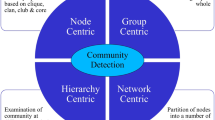Abstract
Maximal Cliques Enumeration (MCE), as a fundamental problem, has been extensively investigated in many fields, such as social networks, and biological science and so forth. However, the existing research works usually ignore the formation principle of maximal cliques which can help us to speed up the detection of maximal cliques in a graph. This paper pioneers a novel problem on detection of bases of maximal cliques in a graph. We propose a formal concept analysis based approach for detecting the bases of maximal cliques and detection theorem. It is believed that our work can provide a new research solution and direction for future topological structure analysis in various complex networking systems.
This research was supported by Basic Science Research program through the National Research Foundation of Korea (NRF) funded by the Ministry of Education (No. NRF-2014R1A1A4A01007190) and the MSIP (Ministry of Science, ICT and Future Planning), Korea, under the ITRC (Information Technology Research Center) support program (IITP-2016-H8601-16-1009) supervised by the IITP (Institute for Information & communications Technology Promotion and was also supported by the Fundamental Research Funds for the Central Universities (GK201703059). Z. Pei’s work was partially supported by National Nature Science Foundation of China (Grant No. 61372187).
Access this chapter
Tax calculation will be finalised at checkout
Purchases are for personal use only
Similar content being viewed by others
References
Conte, A., De Virgilio, R., Maccioni, A., et al.: Finding all maximal cliques in very large social networks. In: Proceedings of EDBT, pp. 173–184 (2016)
Xu, Y., Cheng, J., Fu, A.W.C.: Distributed maximal clique computation and management. IEEE Trans. Serv. Comput. 9(1), 110–122 (2016)
Modani, N., Dey, K.: Large maximal cliques enumeration in large sparse graphs. In: Proceedings of 15th International Conference on Management of Data, pp. 1377–1378 (2009)
Eppstein, D., Loffler, M., Strash, D.: Listing all maximal cliques in sparse graphs in near-optimal time. In: Proceedings of 21st International Symposium on Algorithms and Computation, pp. 403–414 (2010)
Cheng, J., Zhu, L., Ke, Y., Chu, S.: Fast algorithms for maximal clique enumeration with limited memory. In: Proceedings of 18th ACM SIGKDD, pp. 1240–1248 (2012)
Goodrich, M.T., Pszona, P.: External-memory network analysis algorithms for naturally sparse graphs. In: Proceedings of 19th Europe Conference on Algorithms, pp. 664–676 (2011)
Du, N., Wu, B., Xu, L., Wang, B., Xin, P.: Parallel algorithm for enumerating maximal cliques in complex network. In: Proceedings of Mining Complex Data, pp. 207–221 (2009)
Schmidt, M.C., Samatova, N.F., Thomas, K., Park, B.H.: A scalable, parallel algorithm for maximal clique enumeration. J. Parallel Distrib. Comput. 69(4), 417–428 (2009)
Hao, F., Min, G., Pei, Z., et al.: K-clique communities detection in social networks based on formal concept analysis. IEEE Syst. J. 11(1), 250–259 (2015). doi:10.1109/JSYST.2015.2433294
Hao, F., Park, D.S., Min, G., Jeong, Y.S., Park, J.H.: K-clique mining in dynamic social networks based on triadic formal concept analysis. Neurocomputing 209(C), 57–66 (2016)
Author information
Authors and Affiliations
Corresponding author
Editor information
Editors and Affiliations
Rights and permissions
Copyright information
© 2017 Springer Nature Singapore Pte Ltd.
About this paper
Cite this paper
Hao, F., Park, DS., Pei, Z. (2017). Detecting Bases of Maximal Cliques in a Graph. In: Park, J., Chen, SC., Raymond Choo, KK. (eds) Advanced Multimedia and Ubiquitous Engineering. FutureTech MUE 2017 2017. Lecture Notes in Electrical Engineering, vol 448. Springer, Singapore. https://doi.org/10.1007/978-981-10-5041-1_64
Download citation
DOI: https://doi.org/10.1007/978-981-10-5041-1_64
Published:
Publisher Name: Springer, Singapore
Print ISBN: 978-981-10-5040-4
Online ISBN: 978-981-10-5041-1
eBook Packages: EngineeringEngineering (R0)




